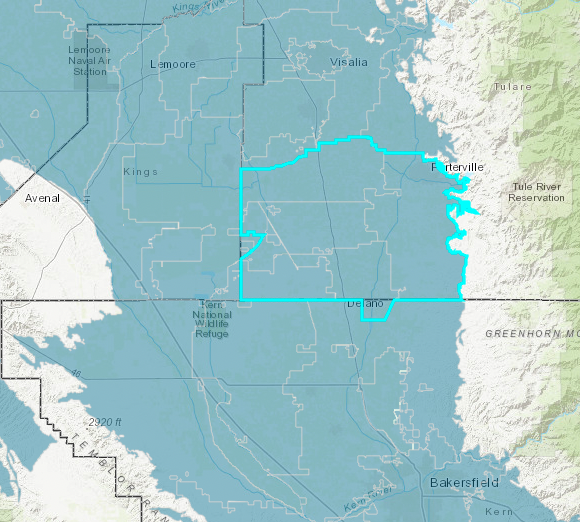Three Tulare County groundwater agencies that cover areas with severe subsidence due to over pumping spent the last year implementing programs to stem that tide and collected more than $11 million in the process.
The Lower Tule River Irrigation District, Pixley Irrigation District and Eastern Tule groundwater sustainability agencies (GSA) are among the first to subject growers to pumping restrictions with associated fees.
Much of that money will go toward paying a share to fix the Friant-Kern Canal, which has sagged in recent years as the land beneath it collapsed from over pumping.
Other revenue collected through pumping fees will pay for water recharge projects to try and replenish the depleted aquifer beneath the GSAs, all of which are in the Tule subbasin.
These efforts are part of the state’s Sustainable Groundwater Management Act (SGMA), which requires overdrafted aquifers be brought into balance by 2040. Generally, that means more water shouldn’t be pumped out than goes back in.
The Tule subbasin had one of the worst groundwater level declines in the San Joaquin Valley, most of which is considered critically overdrafted. But most groundwater sustainability agencies elsewhere in the valley haven’t started implementing fees or pumping restrictions.
“The Tule subbasin is on the leading edge of it,” said Eric Limas, general manager of the Lower Tule River and Pixley irrigation districts.
That’s because the Tule subbasin is the epicenter of the sinking Friant-Kern Canal. The 152-mile canal delivers water to farms and towns throughout the valley. But over pumping severely damaged a 33-mile stretch of the canal which has lost up to 60% carrying capacity in some sections. The Tule subbasin covers the southern half of the valley portion of Tulare County. Together, the Eastern Tule, Pixley and Lower Tule River GSAs cover most of that subbasin.
“We had to try to do as much as we can as soon as we can to address that,” said Rogelio Caudillo, general manager of the Eastern Tule GSA, in regards to the sinking canal.
The Pixley Irrigation District and Eastern Tule GSAs have settlement agreements with Friant Water Authority, which operates the Friant-Kern Canal. Because farmers in the area are responsible for over pumping, they will also be responsible for helping to pay for the estimated $500 million fix. In January, repairs started on a 10-mile section of of the canal.
Money from those GSAs comes from farmers who are now paying for groundwater allocations. Each of the three GSAs allows for different amounts of groundwater use depending on conditions, but the structure is similar.
The GSAs use evapotranspiration (ET) technology to tell how much water is being used for a crop. ET is the process of water transpiration from plants into the atmosphere. The amount of water coming off crops is typically detected through a mixture of satellite imagery and on-the-ground data collection.
There is a base fee and amount of water that will always be allowed for pumping. That portion is considered the “sustainable yield” of the aquifer.
But instead of slashing farmers’ groundwater supplies down to the sustainable yield right away, the GSAs are ramping down the total amount each farmer can use over time.
The GSA allows for some water above the sustainable yield to be used. That extra water is called “transitional water.” It’s more expensive than sustainable yield and the amount of transitional water gets smaller every five years.
“We know what our sustainability numbers are and then we allow for additional pumping above that,” said Limas. “That then transitions down. Every five years that number gets smaller and smaller until it disappears in 2040.”
In Eastern Tule GSA for example, in 2021 the base sustainable yield was just over one acre foot per acre, per year and cost about $5.12 an acre foot, according to Caudillo.
The transitional water (called Tier 1) was 1.18 acre feet per acre, per year and cost $245 an acre foot.
So, if a farmer had 10 acres, he or she would be allowed to consume a little more than 10 acre feet of base sustainable yield each year at a cost of about $51. If that farmer also used all of his or her Tier 1 water, they would consume an additional 11.8 acre feet, which would cost an additional $2,891 on top of the $51.
Any additional water farmers pump over those amounts is subject to penalty fines of $500 per acre foot.
Eastern Tule GSA has collected about $1.4 million so far in fees from 2021. About 91% of that money will go to Friant Water Authority.
Pixley Irrigation District GSA collected about $5 million in fees in 2021. All of that went to Friant Water Authority to pay off the agency’s full share of fixing the canal.
Pixley was able to secure financing to pay Friant Water Authority in full, according to Limas. Fees from 2022 and beyond will go toward paying off the financing and to launch projects such as groundwater recharge and distribution system infrastructure.
Both Pixley and Lower Tule River irrigation districts are focused on expanding recharge near disadvantaged communities, said Limas. Those communities are the first places the district is targeting to offset dropping groundwater levels, which have put small communities’ drinking water supplies at risk.
Other valley GSAs have similar plans. Madera County GSA has developed a pumping program similar to the Tule GSAs.
The Mid-Kaweah GSA, which stretches from Corcoran to Visalia, is likely going to implement pumping restrictions soon, said Aaron Fukuda, general manager of Tulare Irrigation District and executive director of the Mid-Kaweah GSA. He will probably recommend beginning the program in May.
Share this:
- Click to share on Facebook (Opens in new window)
- Click to share on Twitter (Opens in new window)
- Click to share on LinkedIn (Opens in new window)
- Click to share on Reddit (Opens in new window)
- Click to share on Tumblr (Opens in new window)
- Click to share on Pinterest (Opens in new window)
- Click to share on Pocket (Opens in new window)
- Click to share on Telegram (Opens in new window)
- Click to share on WhatsApp (Opens in new window)
- Click to print (Opens in new window)








